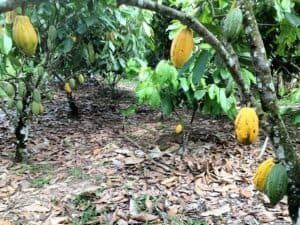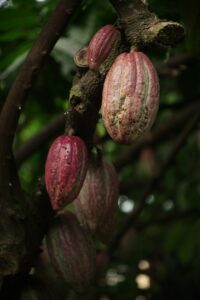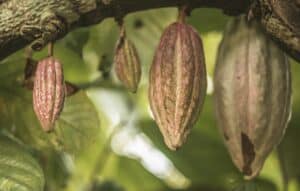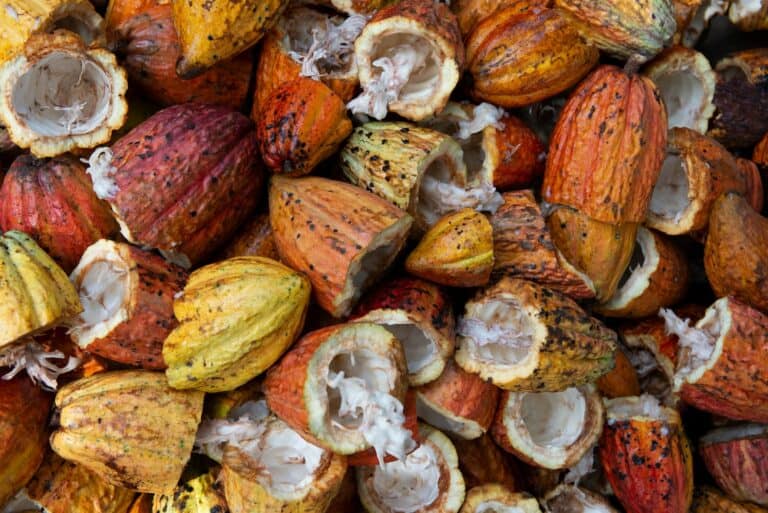In the world of sweet indulgence, chocolate holds a special place, mesmerizing taste buds and sweetening life’s special moments. The key ingredient in chocolate, cocoa, is sourced from the tropical realms, particularly West Africa and South America. However, an underlying bitterness is tainting the sweetness of chocolate. It’s linked to the alarming environmental and socio-economic issues surrounding cocoa farming. This drives the increasing global focus on ‘cocoa sustainability practices.’
For a product to be truly sustainable, its production must neither harm the environment nor human rights and should contribute positively to the livelihoods of those who produce it.
Understanding Cocoa Farming

Cocoa beans, which are the foundation for all cocoa products and chocolate, are harvested from cocoa trees grown primarily in the equatorial regions. Particularly, Côte d’Ivoire and Ghana are the major cocoa-producing countries, contributing to over two-thirds of the world’s cocoa supply.
Cocoa farming communities, located in these regions, face numerous challenges including child labor, farmer poverty, and rapidly changing climate conditions. These hardships, combined with inadequate returns from cocoa, significantly affect farmer livelihoods.
The Importance of Sustainable Practices in Cocoa Farming
Conventional cocoa farming relies heavily on monoculture, resulting in deforestation and adverse environmental impact. However, adopting sustainable cocoa production is a step in the right direction. This approach addresses several aspects, including fair pay, a concentration on the farmers’ social conditions, and careful management of the farms and the environment.
Overview of Cocoa Sustainability Practices

Sustainable cocoa is not an abstract concept but is grounded in tangible methods and practices that contribute to comprehensive cocoa sustainability. At the heart of this lies the encouragement of farmers to adapt and integrate ethical labor practices.
Adhering to organic and fair-trade standards ensures products like cocoa beans come from farms that do not engage in harmful farming practices. Additionally, practices like agroforestry, where cocoa trees are grown along with other crops, not only promote bio-diversity but also contribute to income diversification, easing dependency on a single crop.
Case Studies and Examples of Successful Sustainability Practices
Numerous success stories are emerging from the cocoa sector, highlighting the tangible benefits of implementing sustainable practices. Companies like Barry Callebaut, are seen embracing the Forests Initiative, a protected areas management system, effectively reducing deforestation areas from their cocoa supply chains.
Role of Consumers and Companies in Cocoa Sustainability
Companies play a key role, as they work closely with cocoa farming communities, offering training and tools for growing cocoa in a way that supports sustainability requirements. Customers too can contribute by choosing sustainable chocolate, creating a market demand that favors the promotion of sustainable cocoa production.
Future of Cocoa Sustainability
While several major steps have been taken to promote the sustainability of the cocoa industry, several risk factors still exist, whose addressal, is crucial for the survival and sustainability of cocoa farming communities.
The demand for cocoa is expected to rise, suggesting the need for more cocoa production. Cocoa farmers, therefore, need to find a way to produce more from less land, leading them to employ methods such as carbon sequestration.
Practices like ending deforestation in cocoa supply chains, ensuring gender equality on the farm, and maintaining a living income for farmers are being adopted by some sections of the industry. However, these practices need to be mainstreamed throughout the sector.
The Vital Essence of Cocoa Farms and Cacao Trees
Cocoa farms, the starting point of our indulgent cocoa products, are home to the indispensable cacao trees. These fast-disappearing tropical treasures produce the cacao pods, where our valued cocoa beans originate. Cacao production has, unfortunately, been marked by non-sustainable farming methods that aim only at increased yield, ignoring long-term impacts.
Cacao Trees: The Prolific Producers of the Cocoa Bean

Cacao trees, a crucial part of the biodiversity-rich tropical ecosystems, often fall victim to excessive deforestation. A shift to cocoa sustainability practices enhances the role of these trees beyond just cocoa bean production. Their potential for carbon capture can significantly help combat climate change when cacao production adheres to sustainable frameworks.
The Key Role of Regenerative Farming in Cacao Production
Regenerative farming plays a key role in making cocoa farming a process that gives back to the Earth more than it takes. The core principles revolve around maintaining a healthy soil ecosystem, agricultural biodiversity, and using fair farming practices. Furthermore, this practice contributes to protecting and nourishing the cacao trees for longer sustainable yields.
Higher Prices for Ethically-Sourced, Sustainable Cacao
Sustainable farming tends to incur higher farming costs. However, research indicates that consumers are progressively willing to pay higher prices for ethically-sourced and sustainable cacao and cocoa products. This positive trend acts as an impetus, pushing cocoa farms towards adopting sustainable farming practices. Furthermore, these higher prices can significantly support achieving a living income for farmers and fostering socio-economic stability in cocoa farming communities.
From individual cocoa farmers in West Africa and South America to the companies that process the cocoa beans into chocolate products savored by chocolate lovers worldwide, cocoa sustainability practices need to be at the heart of the entire cocoa supply chain.
While the need for cocoa sustainability is urgent and immense, the progress achieved so far, and the industry’s response to sustainability, paints a picture of hope. Be it the innovation in developing ‘climate-smart cocoa’ systems, lessons learned from successful fair trade practices, or the increased awareness among consumers, there is clear evidence that the chocolate world is moving in the right direction.
By demanding and consuming cocoa and chocolate sourced sustainably, we have the power to influence the industry and ensure that the sweet delight continues to be a joy for future generations. Indeed, chocolate is more than a sweet treat; it is a sustainability story that we are all a part of.
Other suggested articles:
